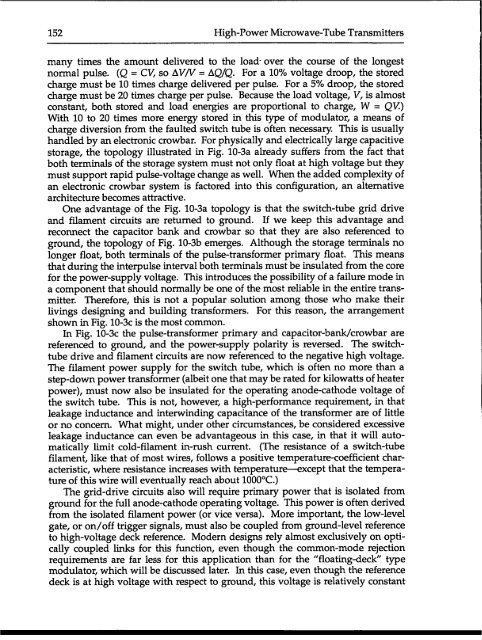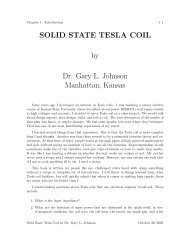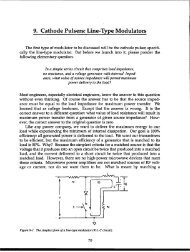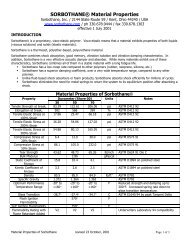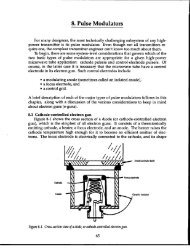3.6M north10.pdf - Dean-O's Toy Box
3.6M north10.pdf - Dean-O's Toy Box
3.6M north10.pdf - Dean-O's Toy Box
Create successful ePaper yourself
Turn your PDF publications into a flip-book with our unique Google optimized e-Paper software.
152 High-Power Microwave-Tube Transmitters<br />
many times the amount delivered to the load- over the course of the longest<br />
normal pulse. (Q = Cw so AV/V = AQIQ. For a 107’ovoltage droop, the stored<br />
charge must be 10 times charge delivered per pulse. For a 5’XOdroop, the stored<br />
charge must be 20 times charge per pulse. Because the load voltage, V, is almost<br />
constant, both stored and load energies are proportional to charge, W = QV.)<br />
With 10 to 20 times more energy stored in this type of modulator, a means of<br />
charge diversion from the faulted switch tube is often necessary. This is usually<br />
handled by an electronic crowbar. For physically and electrically large capacitive<br />
storage, the topology illustrated in Fig. 10-3a already suffers from the fact that<br />
both terminals of the storage system must not only float at high voltage but they<br />
must support rapid pulse-voltage change as well. When the added complexity of<br />
an electronic crowbar system is factored into this configuration, an alternative<br />
architecture becomes attractive.<br />
One advantage of the Fig. 10-3a topology is that the switch-tube grid drive<br />
and filament circuits are returned to ground. If we keep this advantage and<br />
reconnect the capacitor bank and crowbar so that they are also referenced to<br />
ground, the topology of Fig. 10-3b emerges. Although the storage terminals no<br />
longer float, both terminals of the pulse-transformer primary float. This means<br />
that during the interpulse interval both terminals must be insulated from the core<br />
for the power-supply voltage. This introduces the possibility of a failure mode in<br />
a component that should normally be one of the most reliable in the entire transmitter.<br />
Therefore, this is not a popular solution among those who make their<br />
livings designing and building transformers. For this reason, the arrangement<br />
shown in Fig. 1O-3Cis the most common.<br />
In Fig. 1O-3C the pulse-transformer primary and capacitor-bank/crowbar are<br />
referenced to ground, and the power-supply polarity is reversed. The switchtube<br />
drive and filament circuits are now referenced to the negative high voltage.<br />
The filament power supply for the switch tube, which is often no more than a<br />
step-down power transformer (albeit one that may be rated for kilowatts of heater<br />
power), must now also be insulated for the operating anode-cathode voltage of<br />
the switch tube. This is not, however, a high-performance requirement, in that<br />
leakage inductance and interwinding-.<br />
capacitance of the transformer are of little<br />
or no concern. What might, under other circumstances, be considered excessive<br />
leakage inductance can even be advantageous in this case, in that it will automatically<br />
limit cold-filament in-rush current. (The resistance of a switch-tube<br />
filament, like that of most wires, follows a positive temperature-coefficient characteristic,<br />
where resistance increases with temperatun+-except that the temperature<br />
of this wire will eventually reach about 1000”C.)<br />
The grid-drive circuits also will require primary power that is isolated from<br />
ground for the full anode-cathode operating voltage. This power is often derived<br />
from the isolated filament power (or vice versa). More important, the low-level<br />
gate, or on/off trigger signals, must also be coupled from ground-level reference<br />
to high-voltage deck reference. Modern designs rely almost exclusively on optically<br />
coupled links for this function, even though the common-mode rejection<br />
requirements are far less for this application than for the “floating-deck” type<br />
modulator, which will be discussed later. In this case, even though the reference<br />
deck is at high voltage with respect to ground, this voltage is relatively constant


